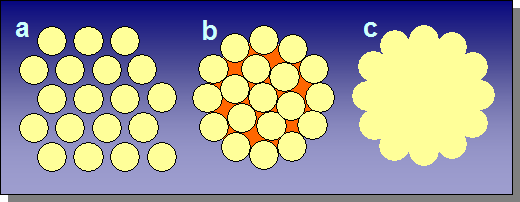Mass excess
As mass defect (also mass loss ) is defined in nuclear physics the difference between the sum of the masses of all nucleons (protons and neutrons) that make up an atomic nucleus, and the actually measured ( always smaller ) mass of the nucleus.
Also the sum of core mass and the masses of the electrons in the atomic shell in a neutral atom is greater than the measured atomic mass. However, this mass defect is much less than the mass defect during assembly of protons and neutrons and is usually neglected.
The mass defect to rebut the presumption of classical physics, the mass remains available at all events.
Mass defect and binding energy
The mass defect can be with the knowledge of relativistic physics explain that one can read off the energy of the particle at rest on the ground: the binding energy of nucleons reduces the sum of the rest energies of the individual core modules. Thus, the liberated during the construction of an atom binding energy of the nucleons is about the relationship equal to the mass defect. The greater the mass defect per nucleon, the more stable the nucleus, since more energy must be expended to its decomposition.
Mass defect at different mass numbers
The total mass defect of a nucleus increases with the mass number, ie the number of nucleons contained. It is measured eg by means of mass spectrometers. If one calculates the average mass defect per nucleon and therefore the binding energy per nucleon ( in units of MeV ), the relationship shown in the picture is the mass number. This quotient of mass defect of nucleons is also called packing fraction.
The highest mass defect per nucleon can be found at nuclides whose nucleus consists of about 60 nucleons. A number of nuclides have almost identical values here. The nuclide with the highest mass defect is nickel -62, followed by the iron isotopes Fe -58 and Fe - 56th
Energy from nuclear reactions
When light nuclides ( located in the left figure from the mass defect - maximum) reach through nuclear fusion ( karyogamy ) has a higher number of nucleons, then increases the mass defect per nucleon; this now also missing mass is converted into energy that can be used. Conversely, put heavy nuclei ( the right of the mass defect situated maximum ) energy is released when they are broken down by nuclear fission into two nuclei of medium mass. An energy -releasing transformation is thus always " towards the maximum of the mass defect ", ie with increasing curve.
However, important in energy technology fusion reactions do not use from the region of highest mass defects in mass numbers by 60, but visible in the figure strong local maximum in the helium isotope 4He, because the relative mass defect increase of the reactants deuterium and tritium to helium is particularly large, and at the same time is the Coulomb barrier that must be overcome for the union of the cores, relatively low.
Calculation
The mass defect of a nucleus arises from the difference in mass of its protons (atomic number = atomic number Z) and neutrons ( neutron number N ) and its actual core mass mK:
To a good approximation can be calculated on the basis of the liquid-drop model of the atomic nucleus on semi-empirical basis by means of the Bethe- Weizsäcker formula.
In practice, the mass defect is not specified for the isolated nucleus, but to the whole, uncharged atom of the respective nuclide. This experimental reasons: Fully ionized, ie " naked" nuclei can be obtained are difficult to handle and, because they immediately capture electrons from the environment with its high positive electric charge. The precise measurement of its mass would be hardly possible, especially with heavy elements ( elements of high atomic number ) and its corresponding particularly high charge.
In the literature there are often arithmetic examples of relatively simple cores, in which the core is considered without electron shell. In tables, but usually referring to the mass defect specified on the whole neutral atom. In such tables, such as Nudat2, so the following relationship applies:
For atoms with the number of nucleons (the atomic mass unit ).
Examples
The mass of a proton is mp = 1.007276 atomic mass units ( u) that a neutron mn = 1.008665 u The core of helium 4He consists of two protons and two neutrons; the sum of the rest masses would be 4.03188 u, the rest mass of the 4He core is only 4.00151 u The mass defect so here is 0.03037 u or 0.76 % of the initial mass.
In the cleavage of 235Uran in 142Barium and 92Krypton
Is the mass of the uranium and the fission -inducing neutrons together 236.053 u, however, the fission products and neutrons have a mass of only 235.860 u. The mass defect in this example is thus 0.193 u or 0.08 % of the initial mass.










